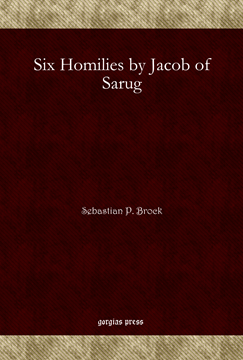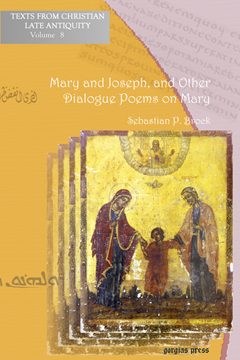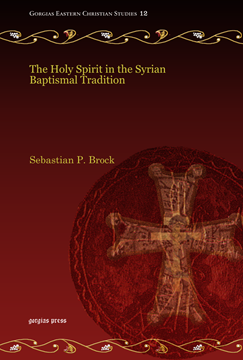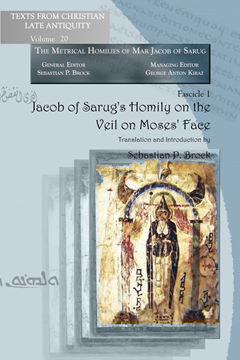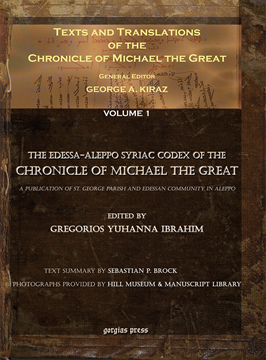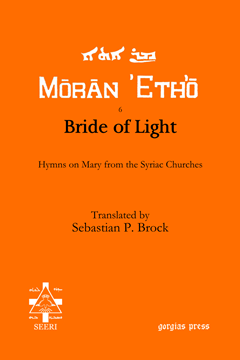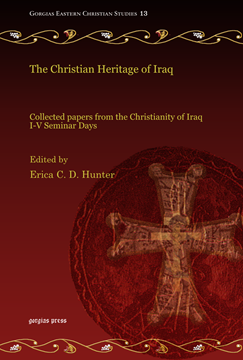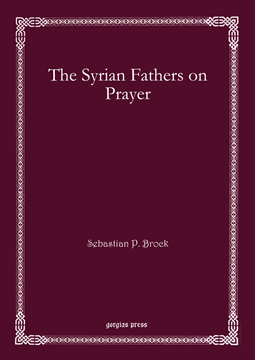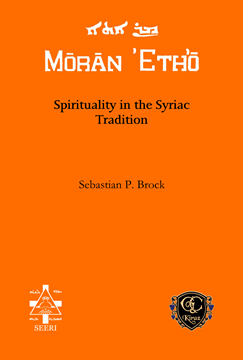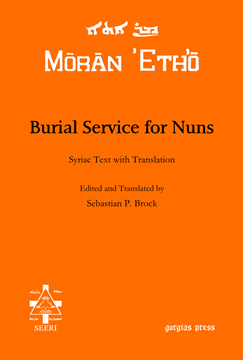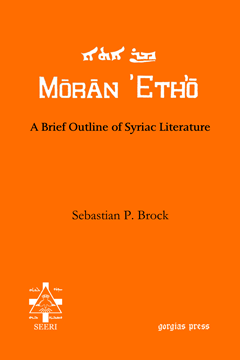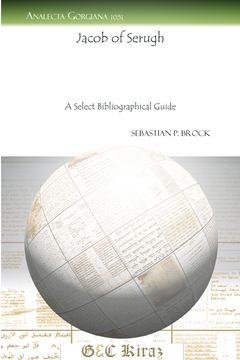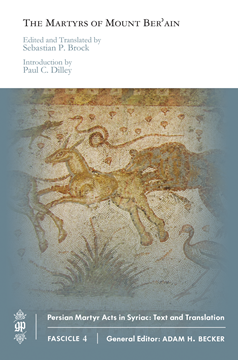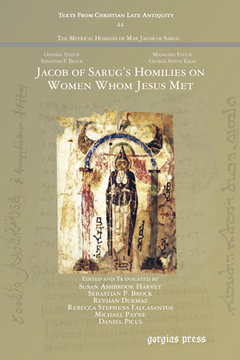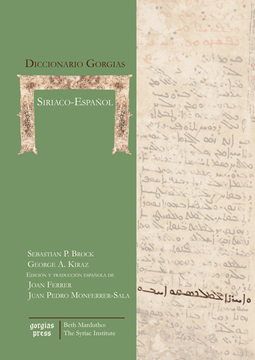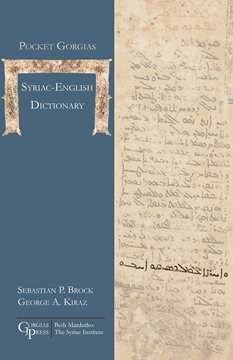Sebastian P. Brock

Emeritus Reader in Syriac Studies, Oxford University, and Emeritus Fellow of Wolfson College, Oxford. Author of a number of contributions in the area of Syriac studies (including several books published by Gorgias Press).
The Bible in the Syriac Tradition (Syriac Version)
Translated from English into Syriac by Eugene Aydin
ISBN: 1-931956-15-4
This is an introduction, written in Syriac, to the Syriac versions of the Bible, with chapters on the manuscript tradition, the main editions, commentaries, and various aspects of the ways the Bible was interpreted and used in the Syriac literary and liturgical tradition. Originally written for a Syriac Studies course at the St Ephrem Ecumenical Research Institute (SEERI), in Kottayam, India, this new edition has been brought up to date and the bibliography expanded.
$70.00 (USD)
The Wisdom of Isaac of Nineveh
A Bilingual Edition
Series: Texts from Christian Late Antiquity 1
ISBN: 1-59333-335-8
From one of the most thought-provoking writers in the monastic tradition, this volume contains 153 short, contemplative sayings of St. Isaac of Nineveh (fl. 661-681 CE) in their original Syriac with facing English translation. St. Isaac was ordained bishop of Nineveh but resigned his post only five months later and became a monastic hermit in the mountains of southeastern Iraq. This work speaks to believing Christians today as well as scholars wishing to learn more about the Eastern monastic tradition.
$32.00 (USD)
Selected Dialogue Poems [Sugyotho Mgabyotho]
Series: Bar Ebroyo Kloster Publications 1
ISBN: 978-1-59333-442-0
Dialogue poetry is a genre that began in ancient Sumer and continues in rich fashion in the Syriac tradition. Sebastian Brock has selected an edition of twenty six dialogue poems: between the Church and Zion; Abraham and Isaac; Joseph and Benjamin; the body and the soul; Joseph and Mary; the thief and the cherub; Mary and the Magi; the church and the believers; the angel and Mary; among the months of the year; between the angel and Zachariah; death and Satan; Jesus and the faithful; the two thieves; Jesus and John; the sinful woman and Satan; Abel and Cain; and wheat and gold.
$119.00 (USD)
Six Homilies by Jacob of Sarug
ISBN: 978-1-59333-445-1
Jacob of Sarug (451–521) was a prolific writer of the Syriac Church and was known as “the flute of the Holy Spirit and the harp of the believing church”. Sebastian Brock gives the Syriac edition of six homilies written by Jacob: on the birth of our Lord; on the baptism of our Lord; on the Great Lent; on Palm Sunday; on Good Friday; on Easter Sunday. The text is based on an ancient manuscripts preserved in London and dated 609.
$109.00 (USD)
Gorgias Encyclopedic Dictionary of the Syriac Heritage
ISBN: 978-1-59333-714-8
The Gorgias Encyclopedic Dictionary of the Syriac Heritage (GEDSH) is the first major encyclopedia-type reference work devoted exclusively to Syriac Christianity, both as a field of scholarly inquiry and as the inheritance of Syriac Christians today. In more than 600 entries it covers the Syriac heritage from its beginnings in the first centuries of the Common Era up to the present day. Special attention is given to authors, literary works, scholars, and locations that are associated with the Classical Syriac tradition. Within this tradition, the diversity of Syriac Christianity is highlighted as well as Syriac Christianity’s broader literary and historical contexts, with major entries devoted to Greek and Arabic authors and more general themes, such as Syriac Christianity’s contacts with Judaism and Islam, and with Armenian, Coptic, Ethiopian, and Georgian Christianities.
$130.00 (USD)
Mary and Joseph, and Other Dialogue Poems on Mary
Series: Texts from Christian Late Antiquity 8
ISBN: 978-1-59333-839-8
What was Joseph’s reaction when he arrived home to find Mary pregnant? How did Mary manage to persuade him that her child was none other than the Son of God? The Syriac literary tradition had a unique way of answering these sorts of questions raised by the Bible. Dialogue poems (sughyotho) offer lively, thought-provoking, and often delightful re-imaginings of Biblical events. They expand the Biblical stories, giving the familiar characters more dialogue and describing their inner thoughts. The collection provides five dialogue poems featuring Mary, in Syriac original with facing English translation.
$40.00 (USD)
The Holy Spirit in the Syrian Baptismal Tradition
Series: Gorgias Eastern Christian Studies 12
ISBN: 978-1-59333-844-2
A sensitive and evocative treatment of the role of the Holy Spirit in worship. With a keen awareness of the tradition of Syrian Christianity, Brock begins his exploration with the role of the Holy Spirit in the Syriac Bible. A striking aspect of this tradition is the imagery used for the Spirit, including: compassionate mother, fire, olive oil, as well as the more common image of dove. Brock also summarizes commentaries and other literature on the baptismal rite, touching on Syriac literature and works translated from the Greek.
$137.00 (USD)
The History of the Holy Mar Ma‘in
With a Guide to the Persian Martyr Acts
ISBN: 978-1-59333-222-8
The History of Holy Mar Ma‘in of Sinjar tells the story of a Sasanian general during the time of Shapur II (309-79) who suffered persecution after his conversion to Christianity. In this volume, the first in this new series from Gorgias Press, Sebastian P. Brock provides the first edition ever of the Syriac text of the History of Ma‘in as well as the first full translation of it. This volume also includes a basic guide to the whole corpus of Persian Martyr Acts as well as useful indices to these numerous texts.
$44.00 (USD)
Jacob of Sarug’s Homily on the Veil on Moses’ Face
Metrical Homilies of Mar Jacob of Sarug
Translation and Introduction by Sebastian P. Brock
Series: Texts from Christian Late Antiquity 20
ISBN: 978-1-59333-644-8
This edition of Mar Jacob of Sarug's (d. 521) homily on the Veil of Moses asks what the veil means. Jacob finds the hermeneutical key in Paul’s exegesis of Gen. 2:24 – that the man and the woman becoming one symbolizes Christ and the Church. The bride must wear a veil until such time as her bridegroom comes to remove it at their marriage ceremony. The volume constitutes a fascicle of The Metrical Homilies of Mar Jacob of Sarug, which, when complete, will contain the original Syriac text of Jacob's surviving sermons, fully vocalized, alongside an annotated English translation.
$34.00 (USD)
The Edessa-Aleppo Syriac Codex of the Chronicle of Michael the Great
Edited by Gregorios Yohanna Ibrahim; Contribution by Sebastian P. Brock & Hidemi Takahashi; Foreword by George Anton Kiraz
ISBN: 978-1-59333-147-4
The invaluable Chronicle of Michael the Great makes the scholarly resources on this unique manuscript available together for the first time. Now inaccessible, the Chronicle is the largest medieval chronicle known, and is available here for the first time in history as a facsimile copy of the original manuscript. The Chronicle is one of the most important primary sources on the history of the Middle East, especially the period between the rise of Islam and the Crusades.
$292.00 (USD)
Bride of Light
Hymns on Mary from the Syriac Churches
Translated by Sebastian P. Brock
Series: Moran Etho 6
ISBN: 978-1-59333-845-9
Syriac is particularly rich in poetry on Mary. Not only is some of this of great tenderness and beauty, but much is also highly imaginative. The present selection of translations includes lyric poems (several by St Ephrem), five lively dialogues, and a longer narrative poem on Mary and Joseph.
$79.00 (USD)
The Christian Heritage of Iraq
Collected papers from the Christianity of Iraq I-V Seminar Days
Edited by Erica C. D. Hunter
Series: Gorgias Eastern Christian Studies 13
ISBN: 978-1-60724-111-9
Iraq has been a centre of Syriac Christianity for almost two thousand years. This volume of collected papers from the Christianity in Iraq I-V Seminar Days (2004-2008) explores the Christian heritage of Iraq, highlighting the churches’ innate ability to transcend barriers of language, culture, ethnicity and religion.
$193.00 (USD)
The Syrian Fathers on Prayer
Series: Bar Ebroyo Kloster Publications 34
ISBN: 978-1-61143-228-2
The Syriac translation of Sebastian Brock's The Teaching of the Syrian Fathers on Prayer, an anthology of writings from the Syriac tradition that focus on prayer and the spiritual life.
$131.00 (USD)
Spirituality in the Syriac Tradition
Series: Moran Etho
ISBN: 978-1-61143-558-0
In the present volume, Sebastian Brock provides an introduction and overview of the unique themes and features of spirituality in the Syriac tradition and includes excerpts from various texts throughout the Syriac tradition that exhibit these features.
$162.00 (USD)
Burial Service for Nuns
Syriac Text with Translation
Edited and Translated by Sebastian P. Brock
Series: Moran Etho
ISBN: 978-1-61143-560-3
Sebastian Brock presents here the Syriac text and English translation of the liturgy for the burial of nuns in the Syriac tradition.
$111.00 (USD)
A Brief Outline of Syriac Literature
Series: Moran Etho
ISBN: 978-1-61143-563-4
Sebastian Brock provides an overview of Syriac literature from the second to the twenty-first century. Brock divides this overview into six historical periods, surveys the important authors and writings of each period, and provides excerpts from some important writings.
$101.00 (USD)
Jacob of Serugh
A Select Bibliographical Guide
Series: Analecta Gorgiana 1051
ISBN: 978-1-4632-0099-2
Brock provides an indispensable bibliographic resource for Jacob of Serugh scholarship. This guide lists Jacob's mimre by biblical passage and liturgical events, uplifted saints and topics, other works including prose and letters, and recommended secondary sources for further study.
$36.00 (USD)
The Martyrdom of St Phokas of Sinope
The Syriac Version
Introduction, translation and edition by Sebastian P. Brock
Series: Texts from Christian Late Antiquity 31
ISBN: 978-1-4632-0189-0
The fame of the martyr St. Phokas, first bishop of Sinope (on the Black Sea) and patron of seafarers, had spread to many parts of the Christian world by the fifth and sixth centuries. Although the Acts of his martyrdom under Trajan were composed in Greek, the earliest witness to them is the Syriac translation which is edited and translated here from two early manuscripts.
$34.00 (USD)
The Syriac Writers of Qatar in the Seventh Century
Series: Gorgias Eastern Christian Studies 38
ISBN: 978-1-4632-0355-9
The Syriac writers of Qatar themselves produced some of the best and most sophisticated writing to be found in all Syriac literature of the seventh century, but they have not received the scholarly attention that they deserve in the last half century. This volume seeks to redress this underdevelopment by setting the standard for further research in the sub-field of Beth Qatraye studies.
$25.00 (USD)
The Hidden Pearl (vol. 3)
Vol. 3: At the Turn of the Third Millennium; The Syrian Orthodox Witness
ISBN: 1-931956-99-5-3
Despite tremendous challenges, Syriac culture and language has survived to the present day. However, massacres and forced migrations have forced Syriac communities to seek homes outside the Middle East, including Germany, the Netherlands, Sweden, America, and Australia. This volume looks at the changing face of Syriac culture in the new millennium and in particular the measures that are being taken to successfully adapt to its new environments. Includes color photographs.
$50.00 (USD)
The Martyrs of Mount Ber'ain
Edited and Translated by Sebastian P. Brock; Introduction by Paul C. Dilley
ISBN: 978-1-4632-0421-1
The Martyrs of Mount Ber’ain is the poignant tale of three noble Iranian siblings who are martyred under Shapur II. Composed in the seventh century, it demonstrates enduring concerns of Christian self-definition in Iran, especially with respect to the Zoroastrian priesthood.
$43.00 (USD)
Jacob of Sarug's Homilies on Women Whom Jesus Met
Edited and Translated by Susan Ashbrook Harvey, Sebastian P. Brock, Professor Reyhan Durmaz, Rebecca Stephens Falcasantos, Michael L. Payne & Prof. Daniel Picus
Series: Texts from Christian Late Antiquity 44
ISBN: 978-1-4632-0580-5
Five homilies by Jacob of Sarug on women whom Jesus met: the Canaanite Woman, the Samaritan Woman, the Hemorrhaging Woman, the Woman Bent Double, and Jairus' Daughter.
$37.00 (USD)
An Anthology of Syriac Writers from Qatar in the Seventh Century
Series: Gorgias Eastern Christian Studies 39
ISBN: 978-1-4632-0545-4
The Syriac writers of Qatar have not received the scholarly attention that they deserve in the last half century. This anthology seeks to redress such an underdevelopment by providing new material in English translation with accompanying Syriac and Garshuni editions to encourage further research in the sub-field of Beth Qatraye studies. It includes the work of some of the most prominent scholars in this field.
$25.00 (USD)
Diccionario Gorgias Siriaco-Español
By Sebastian P. Brock & George Anton Kiraz; Edición y traducción española de Joan Ferrer & Juan Pedro Monferrer-Sala
Series: Gorgias Handbooks 34
ISBN: 978-1-4632-0600-0
El Diccionario Gorgias Siriaco-Español, basado en el Gorgias Concise Syriac-English, English-Syriac Dictionary de Brock y Kiraz, ha sido concebido como un recurso académico, concebido tanto para el siriaco clásico como para el siriaco literario moderno. A Concise Syriac-Spanish Dictionary. Based on Brock and Kiraz's 2015 Gorgias Concise Syriac-English, English-Syriac Dictionary, it is designed to be a convenient academic resource for Classical Syriac.
$48.00 (USD)
Pocket Gorgias Syriac-English Dictionary
Series: Gorgias Handbooks 38
ISBN: 978-1-4632-0707-6
The Pocket Dictionary is both a convenient academic resource and a door into the world of Modern Literary Syriac. With 13,000 entries drawn from the major existing works, it is a practical tool for all but the most specialized Classical Syriac texts.
$45.00 (USD)
- 1
- 2

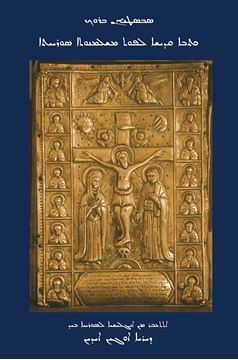

![Show details for Selected Dialogue Poems [Sugyotho Mgabyotho] ImageFromGFF](https://gorgiaspress.com/images/thumbs/0005821_selected-dialogue-poems-sugyotho-mgabyotho_360.png)
